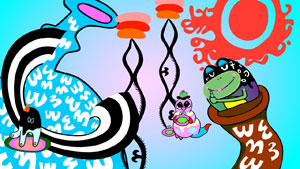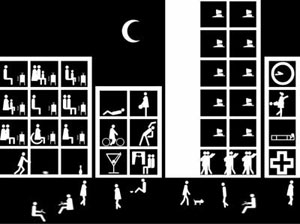Film animation is fun because it’s accessible, meaning there’s no pressure to “get it” in an artsy-serious intellectual way. One can take a scholarly interest, search for literary allusions or Dadaist tendencies for instance, or just get off on lowbrow references to popular culture. Sophisticated or dumb, either approach to the art is comfortable. This playful everyman quality permeates Flicker Fusion, the multi-screen animated film exhibition at DiverseWorks.
Hadacol Christmas (2006), a deliciously twisted cartoon by Brent Green, is possibly the most interesting work in the exhibition. It’s currently on view in the main gallery, but for the opening, Hadacol Christmas and several other Green videos were screened in DiverseWorks’s theater. There, accompanied by two musicians, the artist played guitar and spoke along with his cartoon. Green based the story on his grandfather, who stayed drunk on Hadacol cough syrup. Grandpa is a Santa Claus who stumbles around collecting trash and tinkering with objects to fill up his sleigh. He holds conversations with his scarecrow, indicating a delusional state, while an image of his enlarged and bleeding liver forewarns that he’s on the verge of doing himself in. Once he has filled the sleigh with junk and some crap he has made, it’s time to fly. Loud exhaust pops convince Claus the sleigh will explode so he retains dental records and DNA from his hairbrush. When the sleigh manages to leave the ground, Claus feels exhilarated up there. Up there it is beautiful. “You are too high to make out the mess.” Sleigh items are successfully delivered, but unfortunately Claus passes out in the cold. “We buried you in January.”
Self-taught, Green is a skilled draftsman. His “still” of an elongated, unsteady Claus in an opened red bathrobe with penis exposed is expertly rendered, summoning humor and pathos. Illustrative virtuosity is complimented by striking audio. Green speaks and yells the video’s narration accompanied by extremely talented background musicians. Merging styles – waltz melodies and Hillbilly rock – this is kick-ass music that, as it accompanies the visuals, seems mesmerizing at times. During his opening night performance, Green was accompanied by Jim Becker of “Califone” and Andy Coppinger as they performed the video’s soundtrack in DiverseWorks’s theater.
Green’s other videos, which were also screened at the opening, share the same biographical element that runs through Hadacol Christmas. Carlin, featuring a small stick figure in a wheelchair, is the story of his aunt who moved into his childhood home to die of diabetes. Before her death, she repeatedly entered the hospital for amputation surgeries (you should hear Green sing/howl in this one). Paulina Hollers is the story of a religious fanatic, an old woman who kills herself so she can go to hell to search for her worthless dead son. Green’s family tried to indoctrinate him into the local Evangelical community but it didn’t take.
“I think I was about 25 when I realized other people found this stuff interesting, for instance, that my grandfather’s fingers were torn off his hand,” Green said. His treatment of tragedy and its inherent universality seems more poignant than dark.
Wendy Wagner is the Houston artist in the exhibition. For her video The Eternity of a Second (2007), Wagner has transformed the fantasy creatures from her commercially successful paintings, drawings, and ceramics into a four-minute animation. She also constructed two “snouts” for viewer seating, colorful beanbag-type, pig-nose looking chairs based on her characters. If sitting on snouts makes you feel ridiculous, there’s a bench available.
Wagner’s humor is not perverse in the deliberately vulgar manner typical of some animators. For comedic effect, she uses cartoony creatures with goofy names like “Tootie” to voice metaphysics 101 philosophy – we create our reality with our thoughts.
Wagner asserts that when humans experience a mind lapse, a second seems equivalent to an eternity, thus the video’s title. The concepts of eternity and seconds further serve as metaphors for the animation process in which lengthy durations of output are required to create just seconds of video.
In the video Tootie and her flying snouts travel to Earth where they collect post cards. A character named Miss Pretty calls them back home because she’s experienced a second of mind lapse. The creatures, wondering if a blank mind means they cease to exist, fear their “reality is vanishing” as the video’s text states. The group ends up using their Earth postcards to recreate their memories and their thoughts to conjure improvements on that reality. “Our thoughts are making our world appear,” ends the video. While Wagner’s story might be silly-ass cutesy, her drawings are Disney quality.
Also included in Flicker Fusion is an outrageous piece by Federico Solmi called King Kong & The End of the World (2007). Solmi, an Italian artist living in New York, creates a roughly sketched King Kong to voice the things that piss him off. One of those things is the art world establishment. Kong annihilates the Guggenheim. Corporate America also irritates him; he knocks down the Statue of Liberty with McDonald’s golden arches. Look out investment banker, hedge fund types – Kong “likes to lunch on Wall Street.” The ape chews up a financial dude and then vomits out the pieces. Just before Kong is shot off his skyscraper by a plane, his dick becomes significantly enlarged and he pees down on Manhattan. So there! Solmi uses Kong, his alter ego, to throw a hissy fit. Certain things annoy him in the “neurotic urban landscape” as his website states, and the result is a hilarious cartoon.
Some of the other standout videos include Lars Arrhenius’s The Street (2004), which offers depressing social commentary on monotony and routine in urban life. Jeff Scher’s Paper View (2007) is a non-objective montage of changing color and form. The American Desert (2002) by Mungo Thomson strings together background desert scenery from Roadrunner cartoons. You might find this one slightly too long because it attempts to reference ten years of the cartoons’ landscape illustrations. The viewer keeps expecting that blasted beep-beep bird to appear.
With close to 20 works in the exhibtion, it is not possible to discuss everything in Flicker Fusion, but let’s sign off by mentioning the impressive credentials of the video artists. Many have achieved international acclaim with film festival and museum recognition, and a few are players in the “biz-ness” side of the animation industry. And a comment on presentation – the gallery’s layout is smooth and unfettered. Viewers sit comfortably in front of each white wall screen. Surprisingly, the acoustics aren’t that bad; the gang at DiverseWorks worked hard to build walls that separate the viewing areas. This exhibition is simply fun.
Virginia Billeaud Anderson is an artist and writer currently living in Houston.
All video stills courtesy of the artists and DiverseWorks.






